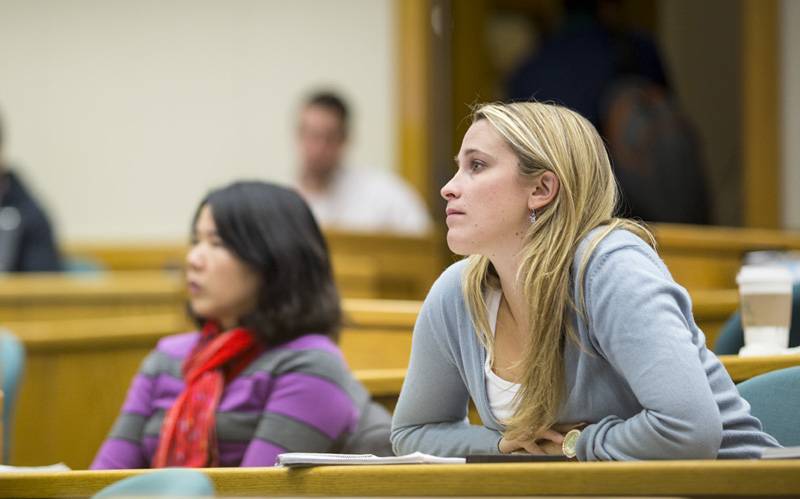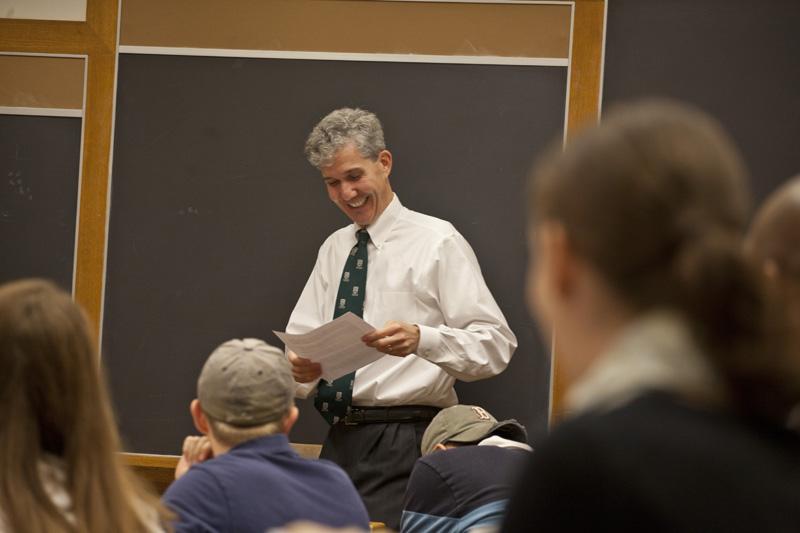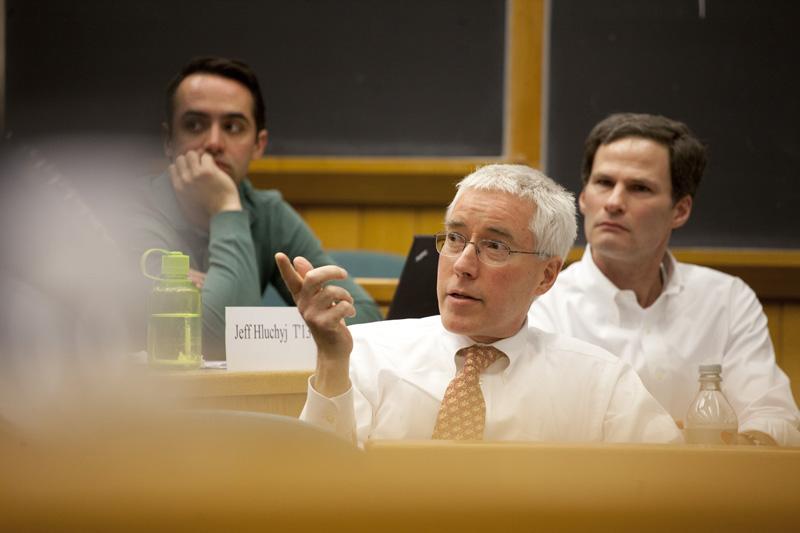Take This Course
A sampling of Tuck’s unique electives unveils a curriculum both deep and wide.

A sampling of Tuck’s unique electives unveils a curriculum both deep and wide.
Seminar on Hedge Funds
Taught by: Rafael La Porta, Noble Foundation Professor of Finance
Class size: 14
Highlight: Final presentation at Lone Pine Capital
Suggested Reading: Expected Returns: An Investor's Guide to Harvesting Market Rewards (Wiley, 2011), by Antti Ilmanen
Hedge fund managers devote much of their careers to answering one question: Buy or sell? Their methods are notoriously private, but not for the students in La Porta’s Seminar on Hedge Funds—for three hours a week, they learn how to do primary investment research in the real world. “We have a number of very successful alumni in this field,” said La Porta. “It would be nice if we could connect them to the students coming up.” In effect, that’s exactly what happens in his class. The students sit at a U-shaped table, and on the video screen, beamed in from their office in Greenwich, Conn., are David Craver T’97 and Marco Tablada T’98, hedge fund managers at Lone Pine Capital, the firm founded by Stephen F. Mandel, Jr. D’78, who is chair of the Dartmouth board of trustees. Craver and Tablada give the students seven companies to research during the term—“highly controversial companies that the students contemplate as possible investments,” La Porta explained. The students then examine a different aspect of their company before each class and report their findings. At the end of the term, they visit Lone Pine Capital and make a final presentation to a new group of managers there. For Ashley Conti T’13, that person-to-person interaction is the best part. “You can’t really hide in the work you’re doing,” she said. “They ask you a lot of questions.”
Social Marketing
Taught by: Punam Anand Keller, Charles Henry Jones Third Century Professor of Management
Class size: 20
Highlight: Creating a marketing plan for a personal goal
Suggested Reading: Social Marketing: Influencing Behavior for Good (Sage, 2008), by Nancy R. Lee and Philip A. Kotler
Marketers do a brilliant job telling us we need something and, in many cases, we follow along. The discipline of social marketing puts a twist on that old relationship. “It’s the application of marketing tools for enhancing individual and collective well-being,” said Punam Anand Keller, the Charles Henry Jones Third Century Professor of Management, who teaches the Social Marketing course at Tuck. Keller is constantly changing and updating the syllabus to keep up with her industry-leading research and consulting in the area. In particular, Keller enjoys helping people make better decisions about their health and wealth, and has worked with CVS/Caremark, the U.S. Treasury, and the Centers for Disease Control, among others, on these challenging aspects of human behavior. Much of the struggle has to do with “inter-temporal discounting,” the phenomenon where people value current costs and benefits more than those that would occur in the future. Since good health and secure finances are the result of small daily decisions that add up in the long term—think exercise and retirement savings—social marketing often strives to get people in touch with their “disconnected selves” that exist abstractly 30 years in the future. In the class, students study cases such as Disney’s decision to put healthy food in its theme parks, and campaigns by Population Services International to encourage Third World residents to use malaria nets and water treatment technology. They apply core marketing principles like segmentation, targeting, and positioning, but toward goals more complex than the corporate bottom line. “They’re inspired and at the same time challenged,” Keller said of her students.
Leadership in the Global Economy
Taught by: Matthew Slaughter, Associate Dean for Faculty and Signal Companies’ Professor of Management
Class size: 60
Highlight: Testifying before a mock Congressional committee
Suggested Reading: The Financial Times, The Wall Street Journal, The New York Times, The Economist

Entrepreneurship, Innovation, and Strategy
Taught by: Ron Adner, Professor of Strategy and Entrepreneurship
Highlight: Dissecting a successful innovation
Suggested Reading: The Wide Lens: A New Strategy for Innovation (Portfolio, 2012), by Ron Adner
“This class has always been a little bit of a laboratory for me to develop ideas,” Ron Adner said. Specifically, it’s been a prompt for Adner to think deeply about the nature of opportunity and threats, and how to approach both in a strategic way. The tangible product of that research and teaching is Adner’s acclaimed first book, The Wide Lens. In it, he presents frameworks and case studies on the importance of ecosystems in innovations ranging from run-flat tires to mobile phones, lessons that he first prepared for his students in Entrepreneurship, Innovation, and Strategy (EIS). While he uses a combination of lectures and case studies, Adner underpins each EIS session with a question in the Socratic tradition. For example: What’s the driver of Apple’s success? Adner and his students dig through the surface answers—beautiful products, great design, an elegant user interface—and hit upon something that goes beyond the conventional wisdom: the way the company was able to partner on a radically new set of terms with, say, the music industry or the mobile phone operators, to capture the value it created through iTunes and the iPhone. More often, Adner will have his students look at failed companies and innovations, tracing back to the subtle flaws in planning and execution. “The power of this course comes from being able to generalize why these blind spots emerge,” said Adner, “And then having the tools to recognize and avoid them in the future.”
Deconstructing Apple
Taught by: Constance E. Helfat, J. Brian Quinn Professor in Technology and Strategy
Class size: 14
Highlight: Helfat assembles a package of research summaries and course notes that students can use in their careers
Suggested Reading: Steve Jobs (Simon & Schuster, 2012), by Walter Issacson
Connie Helfat has been teaching about Apple, Inc. for the better part of 20 years, and it’s easy to understand why. “It’s an iconic company,” she said. “They started what we think of today as the PC industry.” But Apple has lots of other attractive qualities for someone who teaches about technology and strategy: the outsize persona of Steve Jobs; the company’s circuitous rise to dominance; its use of current technology in innovative ways; and its uncanny ability to give consumers exactly what they want. In her unique Research-to-Practice seminar, Deconstructing Apple, Helfat melds the business implications of Apple’s strategy and management decisions with the rigorous academic research that explains why those decisions did or didn’t work. Roughly half of the course readings consist of technical academic articles that, with Helfat’s help, allow the students to dig deeper into strategic theory than they ever have. The goal is to give students ways of evaluating arguments and understanding how to interpret data—habits of mind that will serve them well in their careers. “It really does push them in a way that’s valuable,” Helfat said. “They learn not only how to do this critical thinking, but also the business implications of the literature.” The journal articles are paired each week with typical case studies and news stories, following Apple’s path from its invention of the PC to its near-death experience to its resurgence through iPods, iPhones, and the iPad. Along the way, the students learn practical lessons on international expansion, intellectual property protection, and innovation, among other things.
Energy Economics
Taught by: Robert G. Hansen, Norman W. Martin 1925 Professor of Business Administration; Joseph M. Hall, visiting associate professor of business administration
Class size: 70
Highlight: Class trip to EnerNoc
Suggested Reading: Sustainable Energy—Without the Hot Air (UTI Cambridge, 2009), by David MacKay

Time In The Consumer Mind
Professor: Ellie J. Kyung, assistant professor of business administration
Suggested Reading: "1995 Feels so Close Yet so Far: The Effect of Event Markers on the Subjective Feeling of Elapsed Time," by Gal Zauberman, Jonathan Levav, Kristin Diehl, Rajesh Bhargave, Psychological Science, 2010
Left to its own devices, the human brain is a pretty bad clock. Time seems to speed up when we’re engaged in an interesting task, and slow down when we’re bored. In short, time is an objective phenomenon that humans perceive subjectively. As marketing professor Ellie Kyung knows, this discrepancy has some important implications for consumers and the companies trying to court them. For instance, how do pricing schemes that vary in frequency of payment affect consumption? How can viewing time in different units affect how consumers budget? And do people really think that “time is money?” These and other questions are probed by the students in Kyung’s Research-To-Practice (RTP) seminar, “Time in the Consumer Mind,” a course that draws on Kyung’s research into time perception and her deep familiarity with the academic and practical knowledge on the subject.
“For me, it was difficult to come up with a set of papers for the class,” Kyung said, “because there were so many things I wanted to include.” She started with close to 400 of her favorite journal articles on time perception, grouped them by different topic areas and then narrowed them down to the ones that would spark the most discussion. These academic papers were chosen because, in addition to having practical theoretical implications, they also have intrinsic relevance to the students, since they deal with issues all humans grapple with, such as forecasting our emotions, planning ahead, mental accounting, and goal setting.
This makes the course discussions—led by a different student each week—lively and at times philosophical. During a session on how time affects mindset, for example, the discussion began with an attempt to define happiness. The marketing lesson, however, was strong: simply activating mindsets related to time versus money influences consumer preferences and behavior, making people to be more likely to donate money to charitable causes or feel a greater personal connection to the products they own. “It gives a different perspective to have the opportunity to lead a class,” said Kyung. “You think about material differently, and that’s something you can take with you when you leave Tuck.” For the final project, students have the rare chance to step into the researcher’s role. They design experiments related to time, forming a hypothesis, identifying dependent and independent variables, and coming up with a research plan. “There are lots of ways to run experiments in the workplace, now that we have access to digital platforms,” Kyung explained. “If you think through the process at this level, it becomes much easier to see opportunities for that when you’re doing market research.”
Contemporary Issues in Biotechnology
Taught by: Steven Gillis, adjunct professor of business administration; Michael Zubkoff, professor of health economics and management; Donald P. Conway, adjunct associate professor of business administration
Class size: 38
Highlight: Creating a business plan for a biotech startup
Suggested Reading: Science Business: The Promise, the Reality, and the Future of Biotech (Harvard Business School Press, 2006), by Gary Pisano
Biotechnology, the process of making products out of living systems, has come a long way since the early innovations of plant domestication and the fermentation of beer. Today it’s a $90-billion industry where firms push the limits of scientific knowledge to serve businesses that range from pharmaceuticals to animal food to petroleum refining. The successful biotech firms are those that can combine specialized scientific research capabilities with sharp business skills to raise startup capital, navigate government regulations, and take products to market. Tuck students in Contemporary Issues in Biotechnology have a special guide to this world: Steven Gillis. Not only is Gillis a managing director at ARCH Venture Partners, he’s a highly respected immunologist who has developed treatments for leukemia, run biotech firms, and sold businesses to GlaxoSmithKline and Amgen. Gillis has a Ph.D. from Dartmouth’s Geisel School of Medicine and travels to Tuck from Seattle once a week to teach the course. In five sessions, the course covers the modern history of the industry; starting a biotech company in the aftermath of the Great Recession; the role of government in biotech product development; health care reimbursements, and more. Importantly, the course is made up of students from Tuck as well as the Geisel School and The Dartmouth Institute for Health Policy and Clinical Practice. They team up to review actual prospectuses Gillis has received from biotech startups looking for funding, and to complete the final project: creating a presentation and a business plan for their own biotech firm.